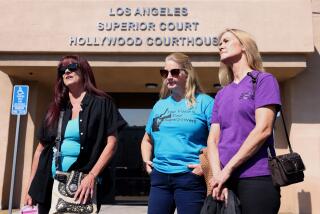5 Years of Police Work Ends With Lucky Break
After four long years of dead ends, the search for the Simi Valley serial rapist was so cold last summer that night-shift officers were told to cruise the city for young men and ask for saliva samples on the spot.
With help from scientists at the county’s crime lab, who analyzed hundreds of swabs volunteered by men during the year, the hope was for a match with DNA evidence left on several victims.
In the end, an arrest came through pure luck.
Vincent Henry Sanchez, 30, of Simi Valley was arrested Sunday after his roommate found sexually explicit materials and newspaper clippings about the crimes in the home he shares with Sanchez, police said.
“This, undeniably, is our guy, and he will not be in the community anymore,” Simi Valley Police Chief Randy Adams said during an afternoon news conference Monday.
Sanchez was jailed and expected to be charged today in connection with 14 rapes and attempted rapes against young women that have haunted the city since the summer of 1996.
“We really want to give credit to the Simi Valley police. They just worked this case as hard as they possibly could,” said Chief Deputy Dist. Atty. Lela Henke-Dobroth, head of the district attorney’s sexual assault unit and one of dozens of people at various law enforcement agencies, including the FBI and the state Department of Justice, who assisted.
In 1998, after seven reported cases, including the assaults of two 15-year-old girls, police officials were certain they were dealing with a serial rapist and boosted the number of investigators from two to a dozen.
Sex-crimes and special-operations officers, including two detectives who worked the case from the start, Kathy Shatz and Gary Galloway, developed physical and psychological profiles of the rapist with help from federal authorities.
He was probably single and living in Simi Valley, they surmised, and had failed at long-term relationships with women. He was probably white or Latino, over 5 feet 6 and of medium size.
He was stalking his victims and seemed to prefer young, slender women with light brown hair. He probably had a minor criminal record for nonsexual offenses like peeping or theft, they thought.
While the number of detectives working the cases would fluctuate between two and a dozen over the years--often depending on the number of tips--Shatz and Galloway spent hundreds of overtime hours poring through criminal files searching for possible suspects.
At one time, the list of suspects swelled to more than 400.
In August 1999, detectives got their first major break when genetic material from three victims matched--establishing the first physical link in the cases.
The genetic material was cross-checked with state and federal DNA files, but no match was found. As detectives suspected, the rapist probably had never been convicted of a sex crime and been forced to give a DNA sample.
When three more cases were reported that year, police officials ordered nighttime patrols stepped up and the City Council offered a $15,000 reward, which was later boosted to $25,000. Simi Valley police began meeting monthly with Los Angeles authorities to determine whether there was any connection between their prey and a series of rapes in the San Fernando Valley.
By March 2000, the number of attacks had reached 11, including two in two days that month, and authorities began warning residents to lock their windows and doors.
Last September, hundreds of members from two dozen churches across the county gathered in Simi Valley for a prayer service to pray for an arrest.
But even as night-shift officers were stopping men matching the suspect’s description and asking for saliva samples, the number of attacks climbed to 14 by November.
More to Read
Sign up for Essential California
The most important California stories and recommendations in your inbox every morning.
You may occasionally receive promotional content from the Los Angeles Times.









